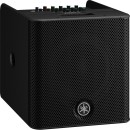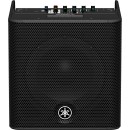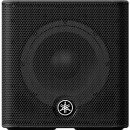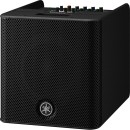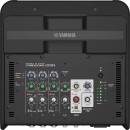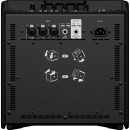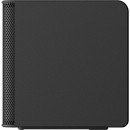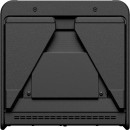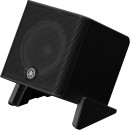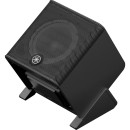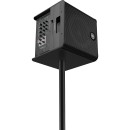Yamaha STAGEPAS 200BTR Portable PA System Review
- Compact and lightweight design for easy portability.
- 200-watt power output for clear and powerful sound.
- Bluetooth connectivity for wireless audio streaming.
- Built-in 3-channel mixer for versatile input options.
- Integrated reverb effects to enhance audio quality.
- Battery-powered option for use in locations without power access.
- Feedback suppressor to minimize unwanted noise.
- Durable construction suitable for various environments.
- User-friendly interface for quick setup and operation.
Specifications, Advantages, and Disadvantages
The Yamaha STAGEPAS 200BTR Portable PA System is a compact yet powerful solution for musicians, DJs, and anyone in need of a reliable sound system on the go. Designed with versatility in mind, this portable PA system combines high-quality audio performance with user-friendly features, making it perfect for a variety of events, from small gigs to outdoor gatherings.
One of the standout features of the STAGEPAS 200BTR is its Bluetooth connectivity, allowing users to easily stream music or other audio content wirelessly from their devices. This makes it incredibly convenient for users who want to integrate playlists or backing tracks into their performances without the hassle of cables. Additionally, the system includes a range of inputs and a built-in mixer, giving users the flexibility to connect microphones, instruments, and other audio sources.
The system is designed to be highly portable, with a lightweight and compact design that doesn’t compromise on sound quality. The high-efficiency amplifier and custom-designed speakers deliver clear, powerful audio that can fill a room or outdoor space. Whether you're a solo artist, a band, or an event organizer, the Yamaha STAGEPAS 200BTR provides high-quality, reliable sound in a portable package.
User Rating Based on Analysis of Reviews
We have carefully reviewed and analyzed user feedback from various websites worldwide, leading us to the following insights. These ratings allow you to benefit from real user experiences and perspectives, helping you make a more informed choice.
Purchase Value
85% of users expressed satisfaction with the purchase value of the Yamaha STAGEPAS 200BTR Portable PA System. They highlighted the system's affordability in relation to its features and performance, noting that it offers excellent sound quality and portability for the price. Users appreciated the system's all-in-one design, which eliminates the need for additional equipment, further enhancing its value for money.
15% of users felt dissatisfied with the purchase value, primarily due to the system's cost compared to other models with similar features. Some users mentioned that while the system is compact and convenient, the initial investment might not be justified for those who require only basic sound reinforcement.
Sound Quality
90% of users were pleased with the sound quality of the Yamaha STAGEPAS 200BTR. They praised its clear and powerful sound output, which is suitable for both small and medium-sized events. Users particularly noted the system's ability to deliver consistent audio performance across different frequencies, making it a versatile choice for various genres and settings.
10% of users expressed dissatisfaction with the sound quality, citing occasional distortion at higher volumes. Some users also mentioned that the bass response could be improved, particularly for larger venues or outdoor use.
Portability
95% of users were satisfied with the portability of the Yamaha STAGEPAS 200BTR. They appreciated its compact and lightweight design, which makes it easy to transport and set up for gigs or events. The system's battery-powered option was also a significant advantage for users needing mobility and flexibility.
5% of users found portability to be lacking, mainly due to the absence of wheels or a carrying case. These users felt that while the system is lightweight, transporting it over longer distances could be cumbersome without additional carrying aids.
Ease of Use
88% of users found the Yamaha STAGEPAS 200BTR easy to use. They commended the intuitive controls and straightforward setup process, which allowed even those with limited technical knowledge to operate the system effectively. The inclusion of Bluetooth connectivity was also a popular feature, simplifying audio streaming.
12% of users reported dissatisfaction with ease of use, pointing out issues with the Bluetooth pairing process and a learning curve associated with accessing advanced features. Some users felt that the user manual could be more detailed to assist with troubleshooting and system optimization.
Durability
80% of users were satisfied with the durability of the Yamaha STAGEPAS 200BTR. They appreciated the robust construction and high-quality materials that appeared to withstand regular use and transportation without significant wear or damage.
20% of users expressed concerns about the system's durability, highlighting occasional issues with the build quality. Some users experienced problems with the connectors and knobs breaking or becoming loose after extended use, which impacted their perception of the system's longevity.
Design
92% of users were pleased with the design of the Yamaha STAGEPAS 200BTR. They appreciated its sleek and modern appearance, which fits well in various settings. The system's compact design was particularly valued for its ability to blend in without taking up excessive space.
8% of users were disappointed with the design, mainly due to the lack of color options or customizable features. Some users felt that while the design is functional, it lacks the aesthetic appeal that would make it stand out in more visually demanding environments.
Battery Life
78% of users were satisfied with the battery life of the Yamaha STAGEPAS 200BTR. They found it sufficient for most small to medium events, appreciating the convenience of using the system without requiring a constant power source.
22% of users were dissatisfied with the battery life, finding it inadequate for longer events or gigs. Some users reported that the battery depletes faster than expected, necessitating frequent recharges or reliance on a power outlet.
Versatility
87% of users praised the versatility of the Yamaha STAGEPAS 200BTR. They highlighted its ability to handle different audio inputs and outputs, making it suitable for various applications, from live performances to public speaking events.
13% of users felt the system lacked versatility, particularly in terms of output power for larger venues. Some users also mentioned that the limited number of input channels restricts its use in more complex audio setups.
Connectivity
86% of users were satisfied with the connectivity options available on the Yamaha STAGEPAS 200BTR. The Bluetooth functionality and multiple input options were appreciated for providing flexible audio source integration.
14% of users were dissatisfied with the connectivity features, especially regarding occasional Bluetooth connectivity issues. Some users also noted a lack of more advanced connectivity options like Wi-Fi or USB inputs.
Volume Range
84% of users were satisfied with the volume range of the Yamaha STAGEPAS 200BTR. They found it adequate for most indoor and small outdoor events, with the system capable of producing clear and loud sound without distortion at moderate levels.
16% of users were dissatisfied with the volume range, expressing that the system struggles to maintain sound quality at higher volumes. This was particularly noted in larger spaces where users felt the system couldn’t adequately fill the area with sound.
Customer Support
82% of users reported positive experiences with Yamaha's customer support for the STAGEPAS 200BTR. They appreciated the prompt and helpful responses from the support team, which effectively addressed their inquiries and technical issues.
18% of users were dissatisfied with customer support, citing delays in response times and difficulty in reaching knowledgeable representatives. Some users felt that their issues were not resolved adequately, impacting their overall experience with the product.
Compatibility
89% of users were satisfied with the compatibility of the Yamaha STAGEPAS 200BTR. They noted its ability to integrate well with various audio devices and software, making it a flexible option for different audio setups.
11% of users were dissatisfied with compatibility, particularly with certain audio software or older equipment. Some users felt that the system's compatibility was limited, requiring additional adapters or interfaces to connect with certain devices.
Weight
91% of users were satisfied with the weight of the Yamaha STAGEPAS 200BTR, finding it manageable for transport and setup. The lightweight design was especially appreciated by performers and event organizers who frequently move between locations.
9% of users were dissatisfied with the weight, particularly those expecting a more robust system. These users felt that the lightweight design might compromise durability and stability during use.
Aesthetics
83% of users were satisfied with the aesthetics of the Yamaha STAGEPAS 200BTR. They found its design appealing and professional, suitable for a variety of settings without being overly flashy or distracting.
17% of users were dissatisfied with the aesthetics, expressing a desire for more color options or design customization. Some users felt that the system's appearance was too generic and did not reflect their personal style or brand image.
Setup Time
88% of users were satisfied with the setup time of the Yamaha STAGEPAS 200BTR. They appreciated the quick and easy assembly process, which allows for rapid deployment at events or performances.
12% of users were dissatisfied with setup time, particularly due to initial confusion with the system's controls and settings. Some users felt that the setup could be more streamlined with clearer instructions or labeling.
Power Efficiency
79% of users were satisfied with the power efficiency of the Yamaha STAGEPAS 200BTR. They found that the system operates effectively without consuming excessive energy, which is beneficial for battery-operated use.
21% of users were dissatisfied with power efficiency, noting that the battery drains quickly during high-demand performances. Some users expressed concerns about the system's power management capabilities, particularly when using all available features simultaneously.
Feedback Control
86% of users were satisfied with the feedback control features of the Yamaha STAGEPAS 200BTR. They found that the system effectively minimizes unwanted noise and interference, allowing for clearer audio output during performances.
14% of users were dissatisfied with feedback control, experiencing occasional issues with feedback during certain setups. Some users felt that additional feedback suppression features would enhance the system's performance in challenging acoustic environments.
Mixer Features
83% of users were satisfied with the mixer features of the Yamaha STAGEPAS 200BTR. They appreciated the intuitive layout and functionality, which allowed for easy control over various audio parameters.
17% of users were dissatisfied with the mixer features, citing limited capabilities compared to standalone mixers. Some users expressed a desire for more advanced mixing options to cater to complex audio setups.
Effect Options
81% of users were satisfied with the effect options available on the Yamaha STAGEPAS 200BTR. They found the built-in effects to be useful for enhancing sound quality and tailoring audio output to specific needs.
19% of users were dissatisfied with the effect options, feeling that the selection was limited and lacked depth. Some users desired more variety and control over effects to achieve their desired sound profiles.
Bluetooth Range
77% of users were satisfied with the Bluetooth range of the Yamaha STAGEPAS 200BTR. They found it sufficient for most small to medium venues, allowing for wireless audio streaming without significant signal loss.
23% of users were dissatisfied with the Bluetooth range, noting frequent connectivity issues and dropouts at longer distances. Some users felt that the range was limited, restricting their ability to move freely while using wireless audio sources.
In the following sections, we will delve into the detailed specifications of the Yamaha STAGEPAS 200BTR Portable PA System. Our review will cover its strengths and weaknesses, providing you with a thorough understanding of this product's capabilities.
Pros:
- Compact and portable design, making it easy to transport.
- Bluetooth connectivity allows for wireless audio streaming.
- Versatile input options accommodate various audio sources.
- User-friendly interface simplifies setup and operation.
- High-quality sound output suitable for small to medium venues.
Cons:
- Limited power output may not be suitable for very large venues.
- Battery life may be insufficient for extended use without access to power.
- May require additional equipment for more complex setups.
- Higher price point compared to some competitors.
- Lacks advanced features found in more professional PA systems.
Portable PA System
| Speaker Configuration | 1x 2-Way Loudspeaker |
|---|---|
| Number of Input Channels | 5 (3 x Mono, 1 x Stereo) |
| Amplifier Power Rating | HF: 10 W RMS 30 W Peak LF: 90 W RMS 150 W Peak Total: 180 W Peak 100 W RMS |
| Amplifier Class | Class-D |
The Speaker Configuration of the Yamaha STAGEPAS 200BTR Portable PA System features a 1x 2-Way Loudspeaker. This means that the system is designed to reproduce sound across two frequency ranges: high frequencies (handled by the tweeter) and low frequencies (managed by the woofer). This configuration ensures clear audio output, making it suitable for various applications, from live music performances to public speaking events.Show More
With a Number of Input Channels totaling 5, including 3 mono and 1 stereo, the system is versatile in handling different audio sources. The mono channels are ideal for microphones and instruments, while the stereo channel can accommodate devices like keyboards or backing tracks. This variety allows users to connect multiple audio sources simultaneously, enhancing the system's functionality during events.
The Amplifier Power Rating provides insight into the system's performance capabilities, with specific ratings for high-frequency (HF) and low-frequency (LF) outputs. The HF rating of 10 W RMS and 30 W Peak, along with the LF rating of 90 W RMS and 150 W Peak, indicates that the system can deliver a total peak power of 180 W and an RMS of 100 W. Higher power ratings typically result in louder sound with less distortion, allowing for effective sound reinforcement in larger spaces.
Lastly, the Amplifier Class is classified as Class-D, known for its high efficiency and compact size. Class-D amplifiers generate less heat compared to traditional amplifiers, which allows for a lightweight design without sacrificing power output. This characteristic is especially beneficial for portable systems like the STAGEPAS 200BTR, where mobility and performance are key considerations.
Speakers
| Enclosure Type | Bass-Reflex |
|---|---|
| HF Driver | 1x 1" / 2.5 cm Compression Driver |
| HF Voice Coil | 1.4" / 3.6 cm |
| LF Driver | 1x 8" / 20.3 cm Woofer |
| LF Voice Coil | 2" / 5.1 cm |
The Enclosure Type refers to the design of the speaker cabinet, which in this case is a Bass-Reflex design. This type of enclosure uses a vent or port to enhance the low-frequency response of the speaker. By allowing air to move in and out through the port, it can produce deeper bass tones while maintaining clarity. This design is especially beneficial for a portable PA system, as it helps to deliver a fuller sound without requiring larger drivers or additional amplification.Show More
The HF Driver specification indicates that the system is equipped with a 1x 1" (2.5 cm) Compression Driver. Compression drivers are known for their efficiency and ability to produce high frequencies at high sound pressure levels. Their compact size allows for more portable designs while still delivering clear and powerful treble sounds, essential for vocals and high-frequency instruments in a live performance setting.
In terms of HF Voice Coil, the measurement of 1.4" (3.6 cm) refers to the size of the voice coil within the HF driver. A larger voice coil generally allows for better heat dissipation and increased power handling, which translates to improved performance and sound quality at higher volumes. This is particularly important for portable PA systems that may be used in various environments where loud output is necessary.
The LF Driver is specified as a 1x 8" (20.3 cm) Woofer, which is responsible for producing the lower frequencies in the audio spectrum. A larger woofer can move more air, resulting in deeper bass sounds. In portable PA systems, the size of the woofer plays a crucial role in how well the system can reproduce bass-heavy music or effects, ensuring a balanced sound across all frequency ranges.
Finally, the LF Voice Coil size of 2" (5.1 cm) indicates the diameter of the voice coil within the LF driver. A larger voice coil can handle more power and produce better sound quality, especially in the low-frequency range. This is essential for achieving a robust low-end response in a portable PA system, allowing it to perform well in various settings and for different types of audio content.
Signal Processing
| Crossover | High-Pass: 2 kHz, 24 dB/Octave (Internal) |
|---|---|
| Input Pad | |
| EQ | 1x HF Shelf 1x LF Shelf |
| Semi-Parametric EQ | |
| Effects | Yes |
| Filters |
The Crossover feature in the Yamaha STAGEPAS 200BTR Portable PA System is designed to manage different frequency ranges effectively. The high-pass filter operates at 2 kHz with a slope of 24 dB per octave, which means that frequencies below this threshold are gradually attenuated. This helps to ensure that lower frequencies do not interfere with the clarity of higher frequencies, making vocals and instruments sound clearer and more distinct.Show More
Regarding the Input Pad, this specification indicates that there is no input pad included in the system. An input pad is typically used to reduce the level of the input signal, which can be beneficial when dealing with very high-output sources. The absence of an input pad suggests that the system is designed to handle standard input levels without requiring additional attenuation.
The EQ section includes a high-frequency shelf and a low-frequency shelf. This means that users can adjust the gain of frequencies above and below a certain point, allowing for more tailored sound shaping. This flexibility enables users to enhance or reduce specific frequency ranges to better suit the acoustics of the performance environment or personal preferences.
In terms of Semi-Parametric EQ, the Yamaha STAGEPAS 200BTR does not feature this option. Semi-parametric EQs provide more precise control over frequency selection and bandwidth, which can be valuable for detailed sound adjustments. The lack of this feature implies that the system is designed for straightforward operation rather than intricate sound manipulation.
The presence of Effects in the system indicates that users can apply various audio effects to their sound, enhancing the overall experience. This can include reverb, delay, and other effects that add depth and richness to the audio, making performances more engaging and dynamic.
Lastly, the Filters specification reveals that there are no additional filtering options available in this system. Filters can be useful for further refining frequencies and managing unwanted noise. The absence of filters suggests that the system maintains a focus on simplicity and efficiency, catering well to users who may not require complex sound processing features.
Performance
| Frequency Range | 60 Hz to 20 kHz |
|---|---|
| Maximum SPL | 125 dB SPL (Peak) |
| Coverage Angle | 90° H x 90° V |
| Input Sensitivity | XLR Mic Input: -38 dBu 1/4" Line Input: -12 dBu |
| Max Input Level | Line Input: +22 dBu Mic Input: -4 dBu (Balanced) |
| I/O Impedance | 1/4" Line Input: 3 Kilohms (Mono) XLR Mic Input: 3 Kilohms (Balanced, Mono) 1/4" Hi-Z Input: 1 Megohms (Mono) 1/4" TRS Aux Input: 10 Kilohms (Stereo) |
| Protections |
The Frequency Range of the Yamaha STAGEPAS 200BTR is from 60 Hz to 20 kHz. This specification indicates the range of sound frequencies that the system can reproduce, with the lower limit providing deep bass sounds and the upper limit covering higher frequencies such as vocals and cymbals. A wider frequency range allows for a more accurate and full sound reproduction, making it suitable for various audio applications, from music performances to public speaking.Show More
Maximum SPL refers to the system's ability to produce sound at high volumes without distortion, measured in decibels (dB). The STAGEPAS 200BTR achieves a maximum sound pressure level of 125 dB SPL (Peak), which is quite powerful for a portable PA system. This high SPL means it can effectively fill larger spaces with sound, making it ideal for events like concerts, presentations, and outdoor gatherings.
The Coverage Angle of 90° horizontal and 90° vertical indicates how wide the sound dispersion is from the speaker. A 90° by 90° coverage pattern ensures that the audio is evenly distributed across a large area, which is beneficial in ensuring that an audience can hear the sound clearly from various positions in the room or venue.
Input Sensitivity specifies the required input level for the system to produce a satisfactory output level. For example, the XLR Mic Input has a sensitivity of -38 dBu, while the 1/4" Line Input is -12 dBu. Understanding input sensitivity helps users connect the right audio sources without introducing noise or distortion, ensuring that the system performs optimally with different microphones and instruments.
The Max Input Level indicates the maximum signal level that the inputs can handle before distortion occurs. The Line Input can handle a maximum of +22 dBu, while the Mic Input can handle -4 dBu (Balanced). This specification is crucial for users to ensure they do not exceed these levels, which could lead to unwanted audio artifacts during performances or recordings.
I/O Impedance describes the resistance of the inputs and outputs. The STAGEPAS 200BTR has different impedances for various inputs: 3 Kilohms for the XLR Mic Input, 1 Megohm for the Hi-Z Input, and 10 Kilohms for the TRS Aux Input. Matching the impedance of the connected devices to the system's input can help achieve optimal sound quality and prevent signal loss or degradation.
Protections indicates that the Yamaha STAGEPAS 200BTR does not include built-in protection mechanisms. While this might suggest a simpler design, users should be aware that additional external protection may be necessary to safeguard the system from potential damage during use, especially in varying conditions or high-volume settings.
Connectivity
| Audio I/O | 1x Combo XLR-1/4" 3-Pin Female Balanced/Unbalanced Mic/Line Input 2x Combo XLR-1/4" 3-Pin Female Balanced/Unbalanced Mic/Line/Hi-Z Input 1x 1/4" TRS Female Balanced/Unbalanced Aux Input 1x 1/4" TRS Male Link/Monitor Output |
|---|---|
| Phantom Power | Yes |
| USB I/O | |
| Mobile App Compatible | Yes: Android & iOS App Name: STAGEPAS Functionality: Adjust Settings, Remote Control, Setup |
| Network I/O | |
| Wireless Connectivity | Bluetooth |
| RF Frequency Band | Bluetooth: 2402 to 2480 MHz |
| Bluetooth | 5.0 |
| Bluetooth Profiles | A2DP |
| Pairing | Manual |
| Bluetooth Power Class | 1 |
| Transmitter Power | 15 dBm |
The Audio I/O section of the Yamaha STAGEPAS 200BTR Portable PA System details the various input and output options available for connecting microphones, instruments, and other audio sources. With multiple combo XLR-1/4" inputs, this system allows for the connection of both balanced and unbalanced signals, enhancing its versatility for different performance settings. The inclusion of both mic and line inputs caters to a variety of audio sources, while the Hi-Z input accommodates high-impedance instruments, such as electric guitars. Additionally, the aux input and monitor output provide further flexibility for integrating external devices and managing sound monitoring during performances.Show More
The Phantom Power feature indicates that the STAGEPAS 200BTR can supply phantom power to condenser microphones, which require this power source to operate. This is particularly useful for professionals who rely on high-quality audio capture, as it ensures that their microphones function optimally. The presence of phantom power expands the system's compatibility with a broader range of audio equipment, making it suitable for various applications, from live performances to studio recordings.
In terms of USB I/O, the Yamaha STAGEPAS 200BTR does not support USB connectivity. However, it compensates for this with its Mobile App Compatibility, which allows users to connect their devices via Android or iOS apps. This functionality enables performers to adjust settings, control the system remotely, and set up their audio configurations with ease. The dedicated app enhances user experience by providing a simple and effective way to manage audio settings on the go.
The Network I/O section highlights that there is no direct network connectivity available with this system. However, the Wireless Connectivity feature introduces Bluetooth functionality, allowing users to stream audio wirelessly. With a frequency band ranging from 2402 to 2480 MHz and Bluetooth 5.0 support, the STAGEPAS 200BTR offers robust and stable wireless performance. The Bluetooth profiles, such as A2DP, ensure high-quality audio transmission, while manual pairing and a power class of 1, with a transmitter power of 15 dBm, enhance the system’s range and connectivity reliability, making it ideal for dynamic performance environments.
Power
| Battery Type | 1x Rechargeable Lithium-Ion (Replaceable) |
|---|---|
| Approximate Battery Life | 8 to 10 Hours (Lithium, Low Power) |
| Battery Charging Time | 4 Hours |
| Internal Battery Capacity | 2700 mAh |
| AC Input Power | 100 to 240 VAC, 50 / 60 Hz |
| Power Supply Output | 24 VDC (Included) |
| Power Consumption | 10 W (Idle) 20 W (1/8 Power) |
| DC Input Power | 29.6 VDC |
The Battery Type of the Yamaha STAGEPAS 200BTR Portable PA System features a single replaceable rechargeable lithium-ion battery. This type of battery is known for its efficiency and long lifespan, making it an ideal choice for portable audio systems. The replaceability also ensures that users can maintain the system's performance over time by swapping out the battery when necessary.Show More
With an Approximate Battery Life ranging from 8 to 10 hours, the system is designed to provide ample power for extended use in various settings, such as outdoor events or performances where access to power outlets may be limited. This duration allows users to confidently rely on the system without frequent interruptions for charging.
The Battery Charging Time of 4 hours is relatively quick, which means that users can easily recharge the system between uses. This feature is particularly beneficial for professionals who may need to use the PA system multiple times in a day. A shorter charging time minimizes downtime, keeping the system ready for action.
The Internal Battery Capacity of 2700 mAh indicates the amount of energy the battery can store, affecting how long the system can operate before needing a recharge. A higher capacity generally means longer usage times, which is crucial for events that require sustained audio output.
The AC Input Power specification of 100 to 240 VAC, 50/60 Hz demonstrates the versatility of the system, allowing it to be used in various regions worldwide without the need for additional adapters. This feature enhances the system's portability and usability in different locations.
The Power Supply Output of 24 VDC is included with the system and is necessary for powering the device when connected to an AC outlet. This output ensures that the system operates efficiently while plugged in, providing consistent audio performance without relying on battery power.
Power Consumption values indicate how much energy the system consumes during operation. At 10 W while idle and 20 W at 1/8 power, these figures show that the system is designed to be energy-efficient, which is especially important for battery-operated devices to prolong battery life and minimize operational costs.
Lastly, the DC Input Power of 29.6 VDC is relevant for users who may want to power the system through alternative means, ensuring flexibility in how the PA system is used and making it adaptable for various scenarios.
Physical
| Transport Options | Handle |
|---|---|
| Mounting | 1 x 0.37" / 0.94 cm 3/8"-16 Female (Bottom) |
| Cooling | Convection |
| Construction Material | Plastic |
| Environmental Protection | |
| Dimensions | 12.1 x 11.9 x 11.8" / 307.5 x 301 x 300 mm |
| Weight | 26.5 lb / 12 kg |
The Transport Options feature refers to the means by which the Yamaha STAGEPAS 200BTR Portable PA System can be moved and handled. It includes a built-in handle that facilitates easy transportation, making it convenient for users who need to set up and move the system frequently, such as performers or event organizers. This feature enhances the portability of the system, allowing users to quickly pack and transport it to different venues.Show More
Mounting refers to the integration of a mounting point, specifically a 0.37" / 0.94 cm 3/8"-16 Female threaded socket located at the bottom of the unit. This allows the PA system to be securely mounted on various stands or supports, enabling optimal positioning for sound projection. Having a proper mounting option is essential for achieving the best audio experience, particularly in larger spaces where height can improve sound distribution.
The Cooling system utilizes convection to prevent overheating during operation. This passive cooling method allows air to circulate naturally around the internal components, maintaining an optimal operating temperature. Effective cooling is crucial for ensuring the longevity and reliability of the system during extended use, especially in demanding environments such as concerts or public events.
Regarding Construction Material, the system is made from plastic, which contributes to its lightweight design while providing adequate durability for transport and use. The choice of material helps keep the overall weight down, making it easier to carry without compromising on the resilience required for portable equipment.
The Environmental Protection specification indicates that the Yamaha STAGEPAS 200BTR does not have specific protective features against environmental factors such as water or dust. Users should be cautious about exposing the equipment to harsh conditions to prevent damage, particularly in outdoor settings.
Dimensions give the physical size of the PA system, which is relatively compact, making it suitable for various settings where space may be limited. The size allows for easy placement in small venues while still being powerful enough to deliver quality sound. A compact design also contributes to its portability.
Finally, the Weight of 26.5 lb / 12 kg is an important factor in determining how easily the system can be transported. A lighter weight is advantageous for users who need to carry the equipment frequently, reducing fatigue and making the setup process more manageable. This weight range is generally considered suitable for portable PA systems, striking a balance between durability and ease of transport.
Packaging Info
| Package Weight | 37.58 lb |
|---|---|
| Box Dimensions (LxWxH) | 19.8 x 19.7 x 17" |
Package Weight refers to the total weight of the Yamaha STAGEPAS 200BTR Portable PA System when it is packaged for shipping. A weight of 37.58 lb indicates that this system is relatively portable, allowing users to transport it easily for events, gigs, or presentations. This is an important factor for musicians and presenters who need to move their equipment frequently, as a lighter package can facilitate easier handling and setup.Show More
Box Dimensions (LxWxH) provide the measurements of the packaging in which the system is delivered, specifically 19.8 x 19.7 x 17 inches. These dimensions are crucial for understanding how much space the system will occupy when stored or transported. Knowing the size helps users plan how to fit the equipment into vehicles or storage areas, ensuring that it can be accommodated without issues. Compact dimensions also indicate that the system is designed for ease of transport and setup, making it suitable for various environments.
Customer Questions
How do I connect my Bluetooth device to the Yamaha STAGEPAS 200BTR?
To connect a Bluetooth device to the Yamaha STAGEPAS 200BTR, first ensure the PA system is powered on. Press the Bluetooth button on the control panel to activate pairing mode. On your Bluetooth device, search for available devices and select 'STAGEPAS 200BTR'. Once connected, you will hear a confirmation sound.
Why is there no sound coming from my Yamaha STAGEPAS 200BTR?
Ensure all cables are securely connected and the volume is turned up on both the mixer and your input device. Check that the input channel is correctly set and not muted. Also, verify that Bluetooth devices are properly paired if you're using wireless audio.
How can I update the firmware on my Yamaha STAGEPAS 200BTR?
To update the firmware, download the latest firmware file from Yamaha's support website. Connect a USB drive to your computer and copy the firmware file onto it. Insert the USB drive into the USB port on the STAGEPAS 200BTR, and follow the instructions in the user manual to complete the update process.
What should I do if the Bluetooth connection keeps dropping on my STAGEPAS 200BTR?
Ensure that your Bluetooth device is within range and there are no obstructions between the device and the PA system. Check for interference from other wireless devices. Restart both the Bluetooth device and the STAGEPAS 200BTR, and try reconnecting.
How do I reset the Yamaha STAGEPAS 200BTR to factory settings?
To reset the Yamaha STAGEPAS 200BTR to factory settings, turn off the system. Press and hold the 'Setup' button while turning the power back on. Continue holding the button until the display indicates that the reset is complete.
Can I connect a microphone to the Yamaha STAGEPAS 200BTR?
Yes, you can connect a microphone to the Yamaha STAGEPAS 200BTR. Use an XLR or 1/4" cable to connect the microphone to one of the available input channels on the mixer. Adjust the channel's gain and volume as needed.
How do I adjust the EQ settings on my STAGEPAS 200BTR?
To adjust the EQ settings, use the built-in digital mixer interface. Select the desired channel, then use the EQ controls to adjust the bass, mid, and treble frequencies to your preference. Refer to the user manual for detailed instructions on navigating the EQ interface.
What is the maximum range for Bluetooth connectivity on the STAGEPAS 200BTR?
The maximum range for Bluetooth connectivity on the Yamaha STAGEPAS 200BTR is approximately 10 meters (33 feet), depending on the environment and any potential interference.
How do I connect multiple speakers to the Yamaha STAGEPAS 200BTR?
To connect multiple speakers, use the 'Line Out' jack on the STAGEPAS 200BTR to connect to the input of another speaker system. Ensure that the additional speaker is compatible with the output level of the STAGEPAS 200BTR.
What should I do if my STAGEPAS 200BTR is not powering on?
Check that the power cable is properly connected to both the PA system and a working power outlet. Ensure the power switch is in the 'On' position. If the unit still does not power on, inspect the fuse for any damage and replace it if necessary. If the problem persists, contact Yamaha customer support for further assistance.
